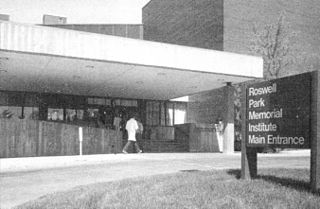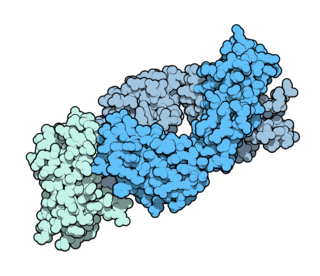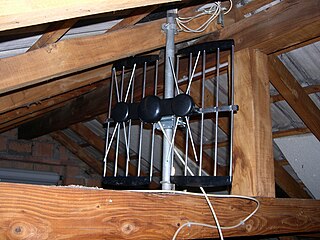
Basal-cell carcinoma (BCC), also known as basal-cell cancer, is the most common type of skin cancer. It often appears as a painless raised area of skin, which may be shiny with small blood vessels running over it; or it may present as a raised area with ulceration. Basal-cell cancer grows slowly and can damage the tissue around it but is unlikely to spread to distant areas or to result in death.
Diathermy is electrically induced heat or the use of high-frequency electromagnetic currents as a form of physical therapy and in surgical procedures. The earliest observations on the reactions of high-frequency electromagnetic currents upon the human organism were made by Jacques Arsene d'Arsonval. The field was pioneered in 1907 by German physician Karl Franz Nagelschmidt, who coined the term diathermy from the Greek words dia and θέρμη therma, literally meaning "heating through".
The Burzynski Clinic is a controversial clinic offering an unproven cancer treatment. It was founded in 1976 and is located in Texas, United States. It is best known for the controversial "antineoplaston therapy" devised by the clinic's founder Stanislaw Burzynski in the 1970s. Antineoplaston is Burzynski's term for a group of urine-derived peptides, peptide derivatives, and mixtures that Burzynski named to use in his "cancer treatment". There is no accepted scientific evidence of benefit from antineoplaston combinations for various diseases.

Roswell Park Comprehensive Cancer Center is a cancer research and treatment center and a New York State public-benefit corporation located in Buffalo, New York and founded by Dr. Roswell Park. Candace S. Johnson, PhD, is President & Chief Executive Officer of Roswell Park Comprehensive Cancer Center. Roswell Park was the first dedicated medical facility for cancer treatment and research in the United States, and is the only upstate New York facility to hold the National Cancer Institute designation of "comprehensive cancer center." Roswell Park Comprehensive Cancer Center, which conducts clinical research on cancer as well as developing new drugs, provides advanced treatment for all forms of adult and pediatric cancer and serves as a member of the National Comprehensive Cancer Network.
Max Gerson was a German-born American physician who developed the Gerson Therapy, a dietary-based alternative cancer treatment that he claimed could cure cancer and most chronic, degenerative diseases.
In a clinical research trial, a clinical endpoint generally refers to occurrence of a disease, symptom, sign or laboratory abnormality that constitutes one of the target outcomes of the trial, but may also refer to any such disease or sign that strongly motivates the withdrawal of that individual or entity from the trial, then often termed humane (clinical) endpoint.
Adjuvant therapy, also known as adjunct therapy, add-on therapy, and adjuvant care, is therapy that is given in addition to the primary or initial therapy to maximize its effectiveness. The surgeries and complex treatment regimens used in cancer therapy have led the term to be used mainly to describe adjuvant cancer treatments. An example of such adjuvant therapy is the additional treatment usually given after surgery where all detectable disease has been removed, but where there remains a statistical risk of relapse due to the presence of undetected disease. If known disease is left behind following surgery, then further treatment is not technically adjuvant.
Coley's toxins is a mixture consisting of killed bacteria of species Streptococcus pyogenes and Serratia marcescens, named after William Coley, a surgical oncologist at the Hospital for Special Surgery who developed the mixture in the late 19th century as a treatment for cancer.

Lapatinib (INN), used in the form of lapatinib ditosylate (USAN) is an orally active drug for breast cancer and other solid tumours. It is a dual tyrosine kinase inhibitor which interrupts the HER2/neu and epidermal growth factor receptor (EGFR) pathways. It is used in combination therapy for HER2-positive breast cancer. It is used for the treatment of patients with advanced or metastatic breast cancer whose tumors overexpress HER2 (ErbB2).
Response evaluation criteria in solid tumors (RECIST) is a set of published rules that define when tumors in cancer patients improve ("respond"), stay the same ("stabilize"), or worsen ("progress") during treatment. The criteria were published in February 2000 by an international collaboration including the European Organisation for Research and Treatment of Cancer (EORTC), National Cancer Institute of the United States, and the National Cancer Institute of Canada Clinical Trials Group. Today, the majority of clinical trials evaluating cancer treatments for objective response in solid tumors use RECIST. These criteria were developed and published in February 2000, and subsequently updated in 2009.
Hoxsey Therapy or Hoxsey Method is an alternative medical treatment promoted as a cure for cancer. The treatment consists of a caustic herbal paste for external cancers or an herbal mixture for "internal" cancers, combined with laxatives, douches, vitamin supplements, and dietary changes. Reviews by major medical bodies, including the U.S. Food and Drug Administration (FDA), the National Cancer Institute, the American Cancer Society, M. D. Anderson Cancer Center, and Memorial Sloan-Kettering Cancer Center, have found no evidence that Hoxsey Therapy is an effective treatment for cancer. The sale or marketing of the Hoxsey Method was banned in the United States by the FDA on September 21, 1960 as a "worthless and discredited" remedy and a form of quackery.

Ipilimumab is a monoclonal antibody that works to activate the immune system by targeting CTLA-4, a protein receptor that downregulates the immune system.
Breast cancer management takes different approaches depending on physical and biological characteristics of the disease, as well as the age, over-all health and personal preferences of the patient. Treatment types can be classified into local therapy and systemic treatment. Local therapy is most efficacious in early stage breast cancer, while systemic therapy is generally justified in advanced and metastatic disease, or in diseases with specific phenotypes.

The Macquarie University Hospital is a private teaching hospital. Macquarie University Hospital, together with the Faculty of Medicine and Health Science, Macquarie University, formerly known as ASAM, Australian School of Advanced Medicine, will integrate the three essential components of an academic health science centre: clinical care, education and research.
Treatment of lung cancer refers to the use of medical therapies, such as surgery, radiation, chemotherapy, immunotherapy, percutaneous ablation, and palliative care, alone or in combination, in an attempt to cure or lessen the adverse impact of malignant neoplasms originating in lung tissue.
The immune cycle is a natural homeostatic oscillation of the immune system when chronic inflammation is occurring. Similar to the menstrual cycle, the exact wavelength and waveform of each particular individual patient is different. That is, different people have different immune cycles although each cycle is typically repeated every seven days.
Avelumab is a fully human monoclonal antibody developed by Merck KGaA and Pfizer as a pharmaceutical drug for use in immunotherapy, originally for the treatment of non-small-cell lung carcinoma (NSCLC).
Loncastuximab tesirine or ADCT-402 is an antibody-drug conjugate (ADC) composed of a humanized antibody targeting the protein CD19, which is expressed in a wide range of B cell hematological tumors. The experimental drug, developed by ADC Therapeutics is being tested in clinical trials for the treatment of B-cell non-Hodgkin lymphoma (NHL) and B-cell acute lymphoblastic leukemia (ALL).

Idiopathic multicentric Castleman disease (iMCD) is a subtype of Castleman disease, a group of lymphoproliferative disorders characterized by lymph node enlargement, characteristic features on microscopic analysis of enlarged lymph node tissue, and a range of symptoms and clinical findings.
The Hallwang Clinic GmbH is a controversial private oncology clinic based in Dornstetten founded in 2014. The CEO is Albert Schmierer, who owns a chain of nearby pharmacies specialising in homeopathy.












